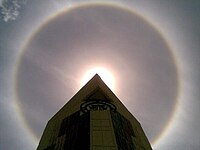User:Valael/Halo (optical phenomenon)


A circumzenithal arc, supralateral arc, Parry arc, upper tangent arc, and 22° halo.

A halo (from Greek ἅλως; also known as a nimbus, icebow or gloriole) is an optical phenomenon produced by ice crystals creating colored or white arcs and spots in the sky. Many are near the sun or moon but others are elsewhere and even in the opposite part of the sky or below the horizon[1]. They can also form around artificial lights in very cold weather when ice crystals called diamond dust are floating in the nearby air.
There are many types of ice halos. They are produced by the ice crystals in cirrus clouds high (5–10 km, or 3–6 miles) in the upper troposphere. The particular shape and orientation of the crystals is responsible for the type of halo observed. Light is reflected and refracted by the ice crystals and may split up into colors because of dispersion. The crystals behave like prisms and mirrors, refracting and reflecting sunlight between their faces, sending shafts of light in particular directions.
Atmospheric phenomena such as halos were used as part of weather lore as an empirical means of weather forecasting before meteorology was developed.
Other common optical phenomena involving water droplets rather than ice crystals include the glory and the rainbow.
Light pillar[edit]

A light pillar, or sun pillar, appears as a vertical pillar or column of light rising from the sun near sunset or sunrise, though it can appear below the sun, particularly if the observer is at a high elevation or altitude. Hexagonal plate- and column-shaped ice crystals cause the phenomenon. It is often caused by water droplets in the sky. Plate crystals generally cause pillars only when the sun is within 6 degrees of the horizon, or below it; column crystals can cause a pillar when the sun is as high as 20 degrees above the horizon. The crystals tend to orient themselves near-horizontally as they fall or float through the air, and the width and visibility of a sun pillar depends on crystal alignment.
Light pillars can also form around the moon, and around street lights or other bright lights. Pillars forming from ground-based light sources may appear much taller than those associated with the sun or moon. Since the observer is closer to the light source, crystal orientation matters less in the formation of these pillars.
Circular halo[edit]

A diffraction disc or Airy disc has similar appearance, but is a disk, rather than a ring, and has a red border on the inside. Its size depends on the size of the ice or water particles that cause it. These are also known as coronas, but are not to be confused with the thin streaming luminous gas that makes up the sun's own corona.
See also[edit]
|
External links[edit]
- Photos and explanation of 22° halo phenomenon
- Halo explanations and image galleries at Atmospheric Optics
- Meteoros AKM - Halo explanations and image galleries
- Halo reports of interesting halo observations around the World
- Southern Hemisphere Halo and other atmospheric phenomena
- Moon Halo Gallery
- Halo in Chisinau Moldova (photo and video)
- Sun Halo appeared in Padang after the earthquake
